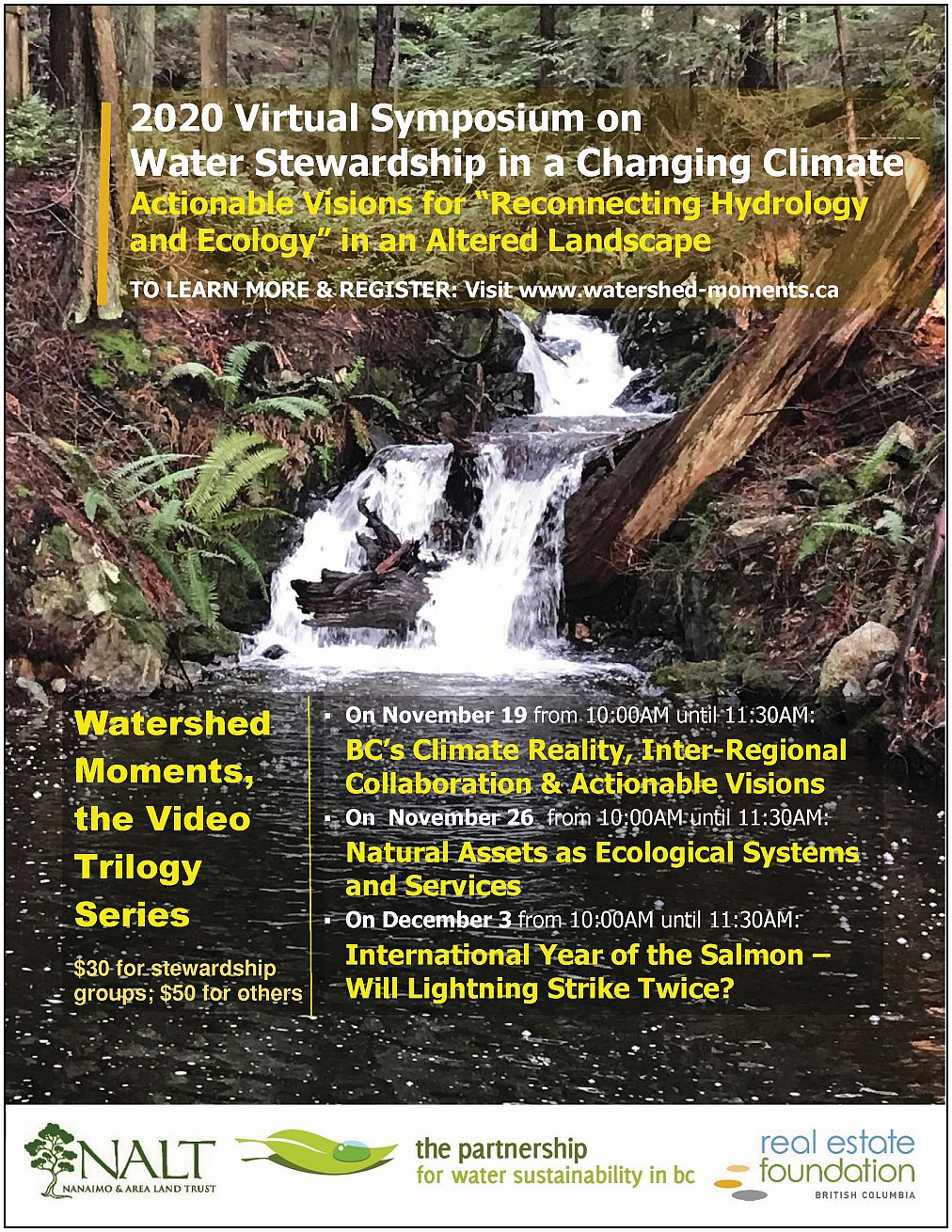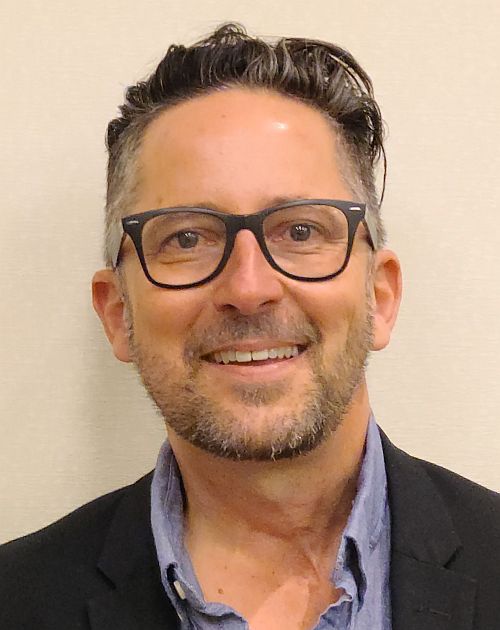NATURAL ASSETS AS ECOLOGICAL SYSTEMS & SERVICES: “MNAI and EAP – it is great that we have two initiatives in British Columbia that focus on the role of natural assets in supporting quality of life and property enjoyment,” stated Emanuel Machado, Town of Gibsons CAO and MNAI Chair. He and EAP Chair Tim Pringle are featured in the second module of “Watershed Moments, the Video Trilogy Series” (November 26, 2020 at 10:00 AM on YouTube)
REGISTER NOW FOR THE VIDEO TRILOGY SERIES:
https://www.civicinfo.bc.ca/event/2020/Third-Water-Stewardship-Symposium-Reimagined
The Registration Fee for the series is a nominal amount –
$30 for stewardship groups and $50 for all others!

FROM ENVIRONMENTAL PROTECTION TO SUSTAINABLE DELIVERY OF CORE SERVICES: “Natural assets support the delivery of core local government services, while doing so much more” – quotable quote from Integrating Natural Assets into Asset Management, September 2019
The sustainability of core service delivery is a concern for local governments across Canada. Rather than continuing to attempt to do more with less, local governments have an opportunity to do things differently – and achieve better results – by including natural assets in asset management processes.
In British Columbia, two programs – MNAI, the Municipal Natural Assets Initiative; and EAP, the Ecological Accounting Process – are facilitating the move from awareness to action in order to account for ecological systems and services. Getting beyond consideration, and actually translating policy objectives into tangible outcomes, requires that local governments have a methodology and metrics for valuing ecological assets and services in an asset management strategy.
What do you know about MNAI and EAP and their respective missions? Do you wonder whether they are the same, or different? Are you aware that MNAI and EAP ask different questions, are complementary approaches, and represent recent evolutions along the ‘green infrastructure continuum’ that had its genesis in the 1990s?
Are you curious and wish to learn more about EAP and MNAI? Then, Watershed Moments is what you have been waiting for! Tim and Emanuel share their passion in a conversation. They elaborate on what it means to transform how local governments view ecological systems and the services they provide. The preview below is a window into what to expect.

Act Like a Watershed: Overcoming Barriers to
Whole-System Action
The year 2015 represents the demarcation for a new era of asset management in British Columbia. The new era was launched when Asset Management for Sustainable Service Delivery: A BC Framework was released. To date, the focus of grant programs administered by the provincial government and the Union of BC Municipalities has been on transforming asset management within the constructed commons.
The BC Framework also set the stage for whole-system action by establishing expectations for maintenance and management of ecological assets within the natural commons. During the period 2015 through 2019, growing awareness that the scope of “asset management for sustainable service delivery” must eventually be expanded to encompass ecological assets resulted in the Primer on Integrating Natural Assets into Asset Management, released in September 2019.
In the video, Tim Pringle and Emanuel Machado discuss barriers and challenges currently limiting progress vis-à-vis whole-system action. They also elaborate on work that is underway by EAP and MNAI to overcome those barriers. In sharing their stories, they will inform, educate and inspire.
EAP is the culmination of a 30-year journey by Tim Pringle, EAP Chair. He has thought about and worked hard to develop and evolve a guiding philosophy, pragmatic strategy and meaningful metrics for valuing the services provided by nature.
Emanuel Machado is the Chief Administrative Officer, Town of Gibsons. He is also the MNAI Chair. He changed the local government conversation. As the ‘face of MNAI’, Emanuel’s philosophy and local government credibility continues to generate momentum for replicating the ‘Gibson’s Model’ in other communities.
Maintenance and Management (M&M) of Ecological Assets
“EAP demonstration applications have yielded three defining conclusions,” states Tim Pringle. “These go to the heart of how practitioners look at the world around us. We must be clear about what our terminology really means. We must be aware of the bias that may be inherent or implicit in our choice of words.
 “So, what are key challenges in communicating a new way of doing business? First, it is insufficient to look at nature primarily as a substitute for engineered infrastructure. We are looking at a system. Without an ecological system, there are no ecological services. Therefore, it is imperative to understand the system as a whole. Everything is connected.
“So, what are key challenges in communicating a new way of doing business? First, it is insufficient to look at nature primarily as a substitute for engineered infrastructure. We are looking at a system. Without an ecological system, there are no ecological services. Therefore, it is imperative to understand the system as a whole. Everything is connected.
“Secondly, it is not yet well-understood that the constructed commons and the natural commons are parallel concepts and of equal importance. Furthermore, a stream in settled areas is a land use. Streams have a defined area and measurement of the financial value can be calculated using BC Assessment data.
“Finally, local governments have existing tools in the form of policies and legislation for ‘maintenance and management’ (M&M) of ecological assets. What they have lacked until now are a pragmatic methodology for financial valuation, and meaningful metrics for effective decision-making and implementation.”
Climate Change, Regulatory Changes and Population Growth
 “Secondly, and as we emphasized in a presentation last summer to the Canadian Council of Environment Ministers, making watersheds resilient to climate change requires alignment and integration amongst all relevant agencies to ensure the ecological integrity of natural assets.
“Secondly, and as we emphasized in a presentation last summer to the Canadian Council of Environment Ministers, making watersheds resilient to climate change requires alignment and integration amongst all relevant agencies to ensure the ecological integrity of natural assets.
“Finally, new collaborative watershed governance models are needed to help local governments tackle climate change, regulatory changes and population growth. We are fortunate that BC has generated significant literature on watershed governance, Indigenous Co-Governance and Collaborative Consent. Given the complexity created by overlapping jurisdictions and the significance of local conditions in both watershed management challenges and solutions, it makes sense to work collaboratively to find effective solutions for our communities.”

DOWNLOAD: https://www.assetmanagementbc.ca/wp-content/uploads/Integrating-Natural-Assets-into-Asset-Management.pdf
Comox Valley is an Incubator Region
For more than a decade, the Comox Valley has been an incubator region for provincially significant precedents in British Columbia. Therefore, it is not surprising that the Comox Valley local government and stewardship sectors have embraced both the EAP and MNAI programs. Seeds were planted at the transformational 2017 Comox Valley Eco-Asset Management Symposium at a time when MNAI and EAP were both embryo initiatives.
Ecological Accounting Process:
EAP is a three-stage initiative: Test / Refine / Mainstream. During 2017 and 2018, the Town of Comox was one of two Stage 1 demonstration applications that tested the concept, and demonstrated EAP relevance to local government. In 2019, two Stage 2 demonstration applications resulted in working definitions and consistent application of the EAP methodology. Next, one of six Stage 3 demonstration applications to mainstream use of EAP will be a Comox Valley project in 2021.
A Beacon of Hope
The Town of Comox experience demonstrates how application of the EAP approach helps managers change practices and adopt new strategies regarding the protection and enhancement of ecological systems in the stream corridor and riparian zone, and throughout the entire creekshed.
To learn more, download a copy of Town of Comox – A ‘Beacon of Hope’ for Citizen Science in Action & Reconnecting Hydrology and Ecology through the Water Balance Approach to Land Development.
Municipal Natural Assets Initiative:
Two MNAI applications are in progress in the Comox Valley. One considers current and future roles of natural assets in the Courtenay River corridor in mitigating flood risks in the downtown core, including the costs and benefits of engineered alternatives. The other addresses the role of nature in protecting the Comox Lake regional drinking water supply, and valuing natural assets.

The parallel concepts of the NATURAL COMMONS and the CONSTRUCTED COMMONS enable residents, elected persons, and practitioners to consider ecological services and use of land (development) as equally important.

